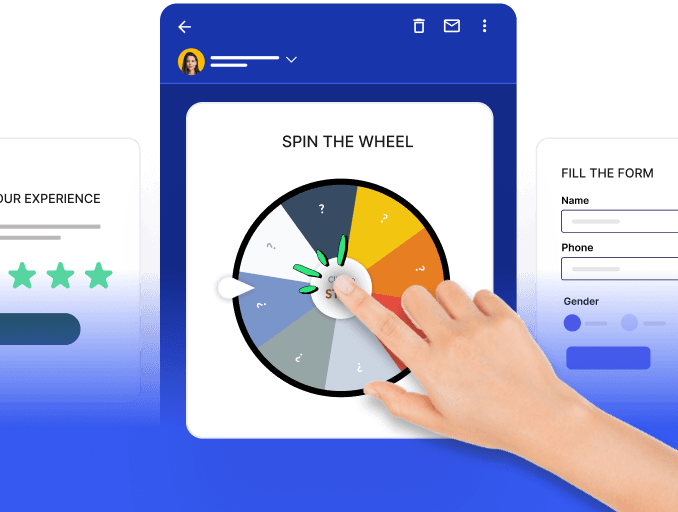The ecommerce industry is a highly competitive one and your success relies heavily on the overall customer experience you provide to your customers. Everything from the products you sell to the website you sell them on must be optimized to provide the best experience possible.
However, ensuring your website provides that can be tricky and may require you to follow a trial-and-error method. This is where A/B testing comes in as a technique that you can use to identify your customers' preferences and modify your website accordingly. This will make your business more desirable to your customers and increase sales. In this guide, you’ll learn how you can use A/B testing in ecommerce to increase sales, along with some best practices and ideas to start with.
Table of contents
What do you mean by A/B testing in ecommerce?
When it comes to ecommerce, A/B testing refers to presenting your website visitors with one of two or more different versions of your landing page, product page, home page and so on and measuring the effectiveness of them both to define which is better based on the conversions that happen on each version.
A/B testing requires sufficient time and sample size for valid test results. A/B testing tools collect the necessary data from session recordings and user behavior data. A/B testing helps make data-driven decisions for conversion rate optimization and improve user experience.
Why is A/B testing important for ecommerce businesses?
A/B testing allows you to understand customer behavior and preferences and tweak your website based on this data. It also fosters a culture of continuous improvement and optimization, leading to maximized sales. Here are some other ways in which A/B testing affects your ecommerce business and helps you improve your ecommerce conversion funnel:
1. Improved return on ad spends (ROAS)
A/B testing allows you to optimize your ad creatives, landing pages and other elements to enhance your ROAS. It does this by testing different ad variations and identifying the most effective copy, design, CTA, etc. You can use this data to create and focus your marketing budget on optimized ad campaigns, leading to higher conversions.
2. Reduced cart abandonment rate
When you A/B test the different elements that your customers interact with while making a purchase on your online store, you can identify the friction points and optimize the checkout process. This enables you to improve the overall customer experience, offer incentives to users to complete the purchase and reduce cart abandonment rates. A/B testing also allows you to identify the right incentives to offer, giving you a better understanding of your customers.
3. Increased revenue
A/B testing allows you to optimize your website and how you recommend products for a better customer experience. This could mean A/B testing the placement, layout or the number of products recommended, which would improve the average order value (AOV). The overall optimization of the website and increase in customer satisfaction also increases customer loyalty, which shows in the increase in customer lifetime value (CLV).
4. Minimized risks of loss
A/B testing allows businesses to optimize their costs and minimizes risk of lowering their sales when a change is implemented on the website. By conducting these tests and collecting enough data, you can make informed decisions instead of relying on assumptions. Testing different elements can help identify and mitigate potential pitfalls before they become major issues. This approach to risk management ensures that your ecommerce business stays ahead of the curve and avoids costly mistakes. For instance, if you are about to revamp your entire website for a new look, you can rely on previous testing data to determine what is preferable to your customers. It’ll help you define the specifics of the website, like dark mode or light mode, the copy, the placement of the CTA buttons and so on.
We've implemented an innovative A/B testing approach: customizing product recommendations beyond the traditional scope—instead of simply varying images or descriptions, we actively personalize suggestions according to customer behavior; a sophisticated algorithm predicts purchase likelihood from browsing history and past actions. Our A/B test matched our algorithm's personalized recommendations with the conventional best-seller list: astonishingly, click-through rates surged by 32%, and conversion rates rose by 24% for those personalized suggestions.
-James Wilkinson, CEO, Balance One Supplements
When should you perform A/B tests?
A/B testing in ecommerce should be an ongoing process instead of a one-time event. You should conduct A/B tests on different pages as well as on different elements of a page. This allows you to stay ahead of the competition and provide and optimized customer experience. Here are some good examples of scenarios in which you should be performing A/B testing:
When optimizing website design
When testing different pricing strategies
When trying out new calls-to-action
When experimenting with different product descriptions
When testing different landing page layouts
When testing different ad designs
Types of A/B testing
There are 4 basic testing methods that businesses use in their ecommerce store optimization. Here they are:
1. Split URL testing
Split URL testing is a process in which you create a new version of an existing web page URL and split website traffic between the original and the variant. The results are then analyzed to decide which out of the two is better. It is used when you wish to make significant changes on the page.
2. Multivariate testing
Multivariate testing is a method in which variations of multiple elements of a page are simultaneously tested to analyze which combination of elements is the best. It’s comparatively more complicated and a more advanced version of a regular A/B test. If you want to experiment with the image, background color and CTA copy, then here’s how you can calculate the total number of versions that you’ll have in a multivariate test if you decide to test all three elements simultaneously:
[No. of versions of ‘image’] X [No.of versions of ‘background color’] X No. of versions of ‘CTA copy’] = [Total no. of variations]
3. Multipage testing
Multipage testing is a method where you experiment with particular elements across all pages. You can experiment with a different version of any recurring element. It allows you to perform a test across the entire conversion funnel.
How to perform A/B testing?
A/B testing is a multi-step process and requires prior planning. Here are the steps that you should follow:
1. Create an objective
The first step in conducting an A/B test is to analyze and understand the current performance of your ecommerce website. This will give you a better picture of the numbers associated with your ecommerce store and help you determine your objective. Following this, you can define your objective as increasing sales, the number of clicks or purchases.
2. Research
Research would include analyzing the performance of various pages of your website using tools like Google Analytics. It’ll help you identify which pages aren’t providing good conversions and need to be optimized.
Further, you can break down conversions into micro-conversions, which are smaller activities or steps of your website visitors that lead to a conversion.
For instance, signing up for a newsletter, adding a product to cart, downloading an ebook, etc., are micro-conversions.
3. Form a hypothesis
In this step, you’ll be stating a hypothesis that will define what needs to changed and what result you are expecting from that change. For instance, you might have a hypothesis that optimizing the CTA button on the landing page will increase the conversion rate by 15%. It’s important that your hypothesis defines the exact element that you are planning to optimize and the result you’re expecting is a measurable metric.
4. Create variations
This is where you create a better version of the element or page that you feel isn’t effective. Following our earlier example, you would create a better variant of the CTA button. You might change the text, color, size, shape or placement of the CTA button.
Remember, if there wasn’t a CTA button before and want to add a new one, you should ideally create two variations to check which one is preferred more by your visitors. However, you only need to create one more variant if you already have one.
5. Run the test
This is the step where you actually run the A/B test. It is preferable to choose an A/B testing tool to do this for you. Tools like Google Optimize, Visual Website Optimizer (VWO) and Optimizely are some notable mentions that allow you to accurately track performance data. It is important that you define things like the size of the sample you want to conduct the test on, the duration of the test and so on. Your A/B testing tool will most likely give you the option to define these.
6. Analyze the results and implement
When the A/B testing is finished, you need to pay close attention to the results and analyze them to understand what went right and what went wrong in each of the variant. Some A/B testing tools even allow you to view the session replays to better understand your customer’s experiences on the page. Ideally, you’ll learn something from both the variants and implement the best of both.
This also gives you a lot of insight into your customers’ preferences and helps you better understand them. Also, when you’ve made sense of what worked, it’s good to implement those changes throughout your website to affect your conversions positively.
Once this A/B test is completed and the results have been analyzed and implemented, you can start with the next one to keep the optimization process ongoing.
Best practices to follow when A/B testing
While A/B testing is a great tool to optimize your website for sale, its effectiveness can diminish very quickly if not done right. Here are some best practices that you should follow when doing A/B testing to achieve exceptional results:
Use a large sample size to achieve accurate and reliable results. For an accurate number, you can use a sample size calculator to find out the sample size by inputting the error margin, confidence level needed and population size.
Test duration shouldn’t be so short that your customers don’t get a chance to interact with the element you’re testing. On average, it should run for a minimum of two weeks. You can even prolong the test if you don’t get enough visitors.
Continually test the different elements one after the other to make the optimization process continuous.
A/B test only one element at a time to specifically identify the effect each variant has on the conversion rate.
Consider the seasonal factors like holiday seasons and the significant imapct it might have on the conversions when analyzing results.
Draw general insights from the results of the tests and document them to better understand the preferences of your customers and refer to them later.
Test across different devices, browsers and platforms.
Don’t delay implementation of significant results after testing.
A/B test ideas for your ecommerce store
Identifying the right elements to test and optimize requires critical thinking. The choices of elements may vary based on the goals you’re trying to achieve, your target audience and so on. To start off, you should always A/B test the messaging, the copy and CTA in every fold of every page. Furthermore, here are some other ideas to get you started.
Homepage
The homepage of your website is the digital storefront of your business. It must be presentable and reflect the theme and goals of your business. One of the most important things to test is the placement and style of the logo and the store name. Some other elements to focus on include:
1. First fold: The first fold of your homepage is responsible for capturing your website visitor's attention. You can experiment with the different elements present there that may nudge the visitor to proceed forward. These elements could be the banner, logo, slogans, copy, etc.
2. CTA: The CTA on the homepage highlights what actions you want the visitor to do. You can have multiple CTAs on your homepage, each performing a different micro-conversion. You can experiment these CTAs in terms of color, shape, copy, placement and so on.
3. Featured products: The featured products displayed on the homepage of an ecommerce website are often the best-selling products of the business. They can be static or dynamic, displayed based on a customer’s preferences and purchase history. You can even experiment with different ways of displaying these products like the size, style, title, price, etc.
Product landing page
It’s common to see businesses have dedicated product landing pages for an upcoming or long-awaited product to create a hyper among the customers. The main purpose of a product landing page is to attract customers and make it visually appealing. If you are creating a new product landing page or the one that you’ve created hasn’t shown the expected results, here are some things to A/B test to optimize the appeal:
1. Header and copy: Test different variations of header copy and other copy that describes the special features and functionalities of the product to figure out what resonates best with the customers.
2. Images and visuals: You can experiment with different visual elements like the color scheme, images, videos, infographics, CTAs, etc. to make your landing page more attractive.
3. Urgency-inducing elements: You can experiment with different urgency-inducing elements like count-down timers till launch, limited stock, etc.
Product listing page
A product listing page is one of the most important pages for an ecommerce website. It’s basically an online brochure of the items that your store sells. Firstly, you can choose to display your products in a list view or a grid view. If you’re not getting enough visitors to click on the products and land on the product detail pages, here are some other elements to focus on A/B testing:
1. Product thumbnails: Product thumbnails are the first point of contact or first impression for any product. You can experiment with different product thumbnails displayed for a product to choose the one that leads the most visitors to the product detail page.
2. Sorting and filtering options: Sorting and filtering options make navigating through the different products and finding the right product easier, ultimately leading to a better customer experience. Test the different ways you can display these options to be easily accessible and have the right filters that your customers would want to use.
3. Pricing: Test the different pricing formats to make sure that complete and accurate information is portrayed to the customers. You might want to include ‘free shipping’ or display the shipping cost separately, the savings on the item or even the installment options.
The most unique idea for an A/B test I can offer to an ecommerce store would be to test 'price anchoring’. This concept involves presenting a higher-priced item first to set an initial price point in the customer's mind, making the rest of the products appear cheaper in comparison. This could drastically shift the shopper's perception of value and potentially increase average order value.
-Michael Giannulis, CEO, Lead Engine Labs
Product detail page
Once a user shows initial interest in a product on a product listing page, it all depends on the product detail page to convince the customer to make the purchase. There are many elements in a product detail page that you can A/B test with to optimize the page if not enough visitors are adding the products to cart or hitting the buy now button:
1. Product images: Your customers would want to see the specific product from all the different angles before they go ahead to purchasing them. You can test the different images, image angles, zoom features, etc. to make sure that the products can be viewed properly. You can also try out different product videos.
2. Product descriptions: It’s important that the product descriptions align with what the buyers want to know about the product they’re viewing. Experiment with the length, tone and style of the product descriptions to make sure they are persuasive and provide complete information.
3. CTA: The goal of your product page is to make the visitors click on the CTA button and complete the purchase. For this, you need to make your CTAs attractive by experimenting with where you place the CTA, the color and the CTA text.
4. Reviews: Positive reviews about a product positively affect a customer’s purchasing decision. You can experiment with the placement of the reviews and the specific reviews you want to display for a product to ensure you get the best results.
Checkout page
The checkout page is the final stage in a buyer’s journey, making it very important for conversion. If your rate of abandoned carts is high, then here are some things you can A/B test in it:
1. Progress indicators: Progress indicators display the progress and the steps remaining in the completion of a checkout process. The absence of one can leave your customers in the dark about the number of pages or steps they’ll have to go through to complete the purchase. You can experiment with different styles of progress indicators like one that shows steps or one that shows a bar that fills gradually as they move forward.
2. Shipping and payment options: You can experiment with different styles you display the shipping and payment options to make it easy for your customers to make a decision. You can have a drop-down of all the payment options for your customers to choose from or you can have them displayed out right. You can have the same for the shipping options available.
3. Number of form fields: Test the number of form fields that you want your customers to fill to complete the purchase. If there are too many, they might abandon the shopping cart but there are certain fields that you’ll always need them to fill to make the purchase possible and make them feel like they’re still in control of the purchase. Test enough to find the right number.
Conclusion
A/B testing is an ongoing process that empowers ecommerce businesses to make data-driven decisions for continuous improvement. By strategically experimenting with different variations of your website, you can do conversion optimization, improve user experience, and ultimately boost sales. However, it’s important to follow the best practices like the ones outlined in this guide to do it right. If you don’t know where to start, you can implement the ideas that we’ve talked about to optimize your ecommerce sales.







